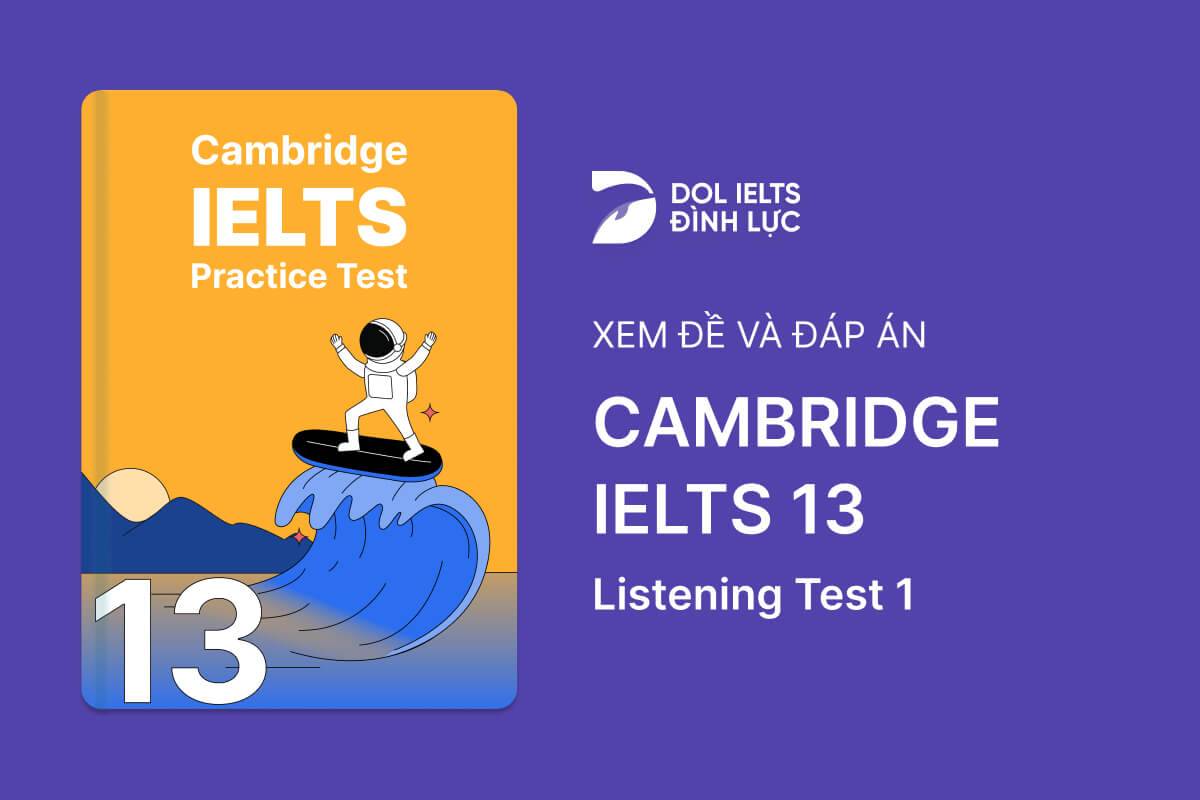Cambridge IELTS 13 - Listening Test 1 With Practice Test, Answers And Explanation
Luyện tập đề IELTS Online Test Cambridge IELTS 13 - Listening Test 1 được lấy từ cuốn sách Cambridge IELTS 13 với trải nghiệm thi IELTS trên máy và giải thích đáp án chi tiết bằng Linearthinking, kèm answer key và list từ vựng IELTS cần học trong bài đọc.
Section
👂️ Bài nghe section 1
❓ Tapescript section 1
🔥 Đáp án & giải thích section 1
Giải thích chi tiết
 Xác định loại từ cần điền là verb
Xác định loại từ cần điền là verb
>> Dự đoán thông tin là 1 động từ đi song song với từ cook (how to ____ and cook)
 Sau khi nhắc đến focus của Food Studio là seasonal products, người quản lý tiếp tục nói rằng the class will not only teach you how to cook them, they also show you how to choose them"
Sau khi nhắc đến focus của Food Studio là seasonal products, người quản lý tiếp tục nói rằng the class will not only teach you how to cook them, they also show you how to choose them"
>> Có nghĩa là khi nghe thấy not only teach you how to cook, mình dự đoán sẽ có 1 động từ còn lại not only … but also … song song với từ cook
>> “Choose” 
Section
👂️ Bài nghe section 2

❓ Tapescript section 2
🔥 Đáp án & giải thích section 2
Giải thích chi tiết
 Sau khi nghe “So why do we need to make these changes to traffic systems in Granford?” là biết đáp án chuẩn bị vào
Sau khi nghe “So why do we need to make these changes to traffic systems in Granford?” là biết đáp án chuẩn bị vào
 Sau đó nghe “ traffic is becoming an increasing problem” và “It’s been especially noticeable with the increase in heavy traffic”
Sau đó nghe “ traffic is becoming an increasing problem” và “It’s been especially noticeable with the increase in heavy traffic”
>> Có thể là đáp án B (tăng lượng traffic)
>> Sau đó nghe But it’s the overall rise in the volume of traffic of all kinds that’s concerning us
>> Nhưng cái khiến mình quan tâm là tăng về số lượng tất cả các loại xe
Section
👂️ Bài nghe section 3
❓ Tapescript section 3
🔥 Đáp án & giải thích section 3
Giải thích chi tiết
 Sau khi nghe câu "I thought we could look at seed germination - how a seed begins to grow" là biết câu trả lời chuẩn bị vào
Sau khi nghe câu "I thought we could look at seed germination - how a seed begins to grow" là biết câu trả lời chuẩn bị vào
 Sau đó nghe Emma hỏi Any particular reason? “ hỏi về lý do tại sao Jack lại muốn nghiên cứu về seed germination
Sau đó nghe Emma hỏi Any particular reason? “ hỏi về lý do tại sao Jack lại muốn nghiên cứu về seed germination
>> “I know you’re hoping to work in plant science eventually” biết Jack muốn làm việc trong lĩnh vực plant science trong tương lai
>> Tuy nhiên nghe tiếp Jack trả lời “Yeah, but practically everything we do is going to feed into that.”
>> Mình thấy có từ but, Nhưng gần như mọi thứ đều giúp họ trong công việc tương lai, cấu trúc feed into sth: help sth to happen, that trong câu chính là work in plant science
Section
👂️ Bài nghe section 4
The
- Because of its general adaptability.31
The pigeon – because walls of city buildings are similar to
.32
Emilie Snell-Rood studied urbanized mammal specimens from museums in Minnesota.
She found the size of their
had increased.34She suggests this may be due to the need to locate new sources of
and to deal with new dangers.35
Catarina Miranda focused on the
of urban and rural blackbirds.36She found urban birds were often braver but were afraid of situations that were
.37
Jonathan Atwell studies how animals respond to urban environments.
He found that some animals respond to
by producing lower levels of hormones.38
Sarah Partan’s team found urban squirrels use their
to help them communicate.39
❓ Tapescript section 4
🔥 Đáp án & giải thích section 4
Giải thích chi tiết
 Xác định loại từ cân điền là noun,
Xác định loại từ cân điền là noun,
>> Có thể là một loài động vật nào đó vì mình thấy từ e.g (ví dụ) và gạch đầu dòng thứ 2 là pigeon: chim bồ câu
 Câu "And we used to think that only a few species could adapt to this new environment."
Câu "And we used to think that only a few species could adapt to this new environment."
>> Là câu thứ 2 trong đề vì có we used to think = it was previously thought
>> Đáp án chuẩn bị vào


